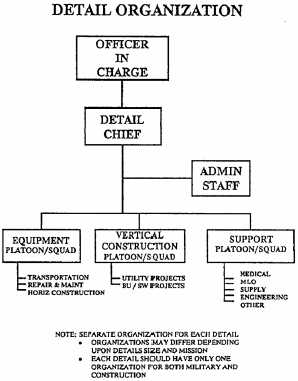concept (fig. 4-2). In this organization the company
commanders are directly responsible to the
operations officer for the timely and successful
completion of construction projects assigned to them
by
the
operations
officer.
The
project
manager/resource manager concept (fig. 4-3) requires
construction projects be assigned directly to a project
manager who is normally outside the company
organization. The project managers are then
responsible directly to the operations officer for the
completion of the project to include the following:
planning, scheduling of resources, direct project
supervision, and reporting. The entire battalion labor
force is reorganized into resource “pods,” either by
rate or by type of work to be accomplished (such as
block crews, concrete crews, finish crews, and wiring
crews). A resource manager is placed in charge of
each pool. The resource manager has the
responsibility to utilize their assigned personnel,
tools, and equipment effectively, without regard to
project assignment, and provide the administration
support required by the military organization. The
self-sufficient unit concept (fig. 4-4) is used when the
battalion establishes details to accomplish specific
tasks at locations remote from the main body site.
These details are organized and staffed with all
resources required to accomplish the specific assigned
mission; therefore, the self-sufficient unit. The three
concepts are outlined in the Naval Construction Force
Manual, NAVFAC P-315.
No matter what construction concept is used,
the prime contractor, project manager, or the officer
in charge (OIC) of the self-sufficient unit is directly
responsible to the operations officer.
DEPLOYMENT PLANNING
The key to a successful deployment is well-developed
plans. This planning phase begins 2 months before
the end of the previous deployment and continues
through the end of home port. More details of how
construction projects are planned and laid out are
covered in the Naval Construction Force/Seabee
Petty Officer First Class, NAVEDTRA 10601, and the
Naval Construction Force/Seabee Chief Petty Officer,
NAVEDTRA 10600. The following is a general
overview of how deployment tasking is planned. The
planning phase is subdivided into seven distinct
steps: initial planning step, follow-on planning step,
detailed planning step, predeployment trip step,
ready-to-deploy evaluation step, advance party phase
(final evaluation step), and the main body arrival
step.
The initial planning step is the period in which
the battalion receives its preliminary tasking and begins
Figure 4-4.-Self-sufficient unit organization.
monitoring the efforts, plans, tasking, and work load
of the on-site battalion at the next deployment site.
The battalion also organizes a planning group that
consist of personnel who are knowledgeable
individuals in their particular rating. This group
monitors the planning and estimating of the
construction projects and performs as the quality
control (QC) team during the deployment.
The
follow-on
planning
step
is
the
preliminary evaluation involving the in-depth study
of all information received to date and the monitoring
of the on-site battalions efforts. Part of the in-depth
study is to evaluate any additional training needs for
battalion personnel and to review and develop an
overall method of execution for any particular project.
After the preliminary evaluation is completed, the
appropriate number of personnel for each detail,
company, and staff elements are assigned. his
evaluation should yield a significant number of
questions which are normally resolved by message
traffic, direct contact, or during the predeployment
trip.
When the detailed planning step is reached, the
battalion is ready to commence the project planning
function. At this time, the companies and details become
the primary planning units within the battalion. Also,
this is when the project supervisor becomes involved
with the planning and it is during this phase that the
4-3


